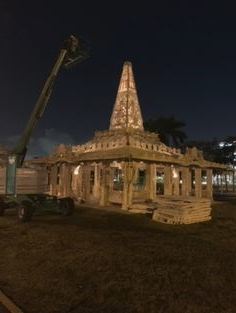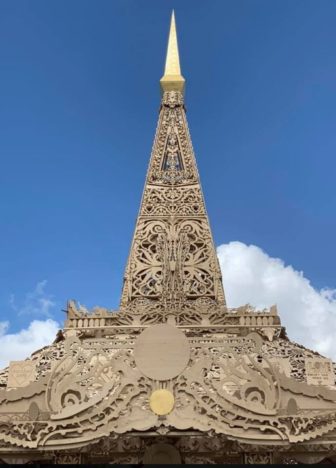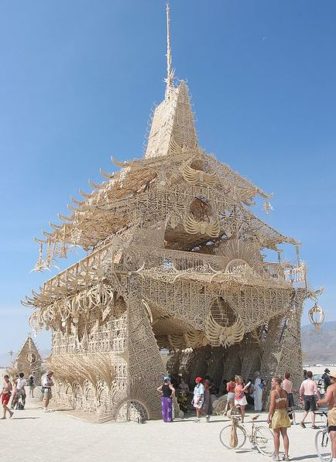CORAL SPRINGS, Fla. – On Feb. 14, The Temple of Time opened in Coral Springs. That day marked the first anniversary of the mass shooting at Marjory Stoneman Douglas High School. It left 34 physical casualties, 17 dead and another 17 injured, and uncountable, far-reaching emotional damage. This temple project mixes grief-work, art, inclusive spirituality, and an engaged community. Marjory Stoneman Douglas High School draws students from two cities, Parkland and Coral Springs. A Bloomberg 2018 Public Art grant and the City of Coral Springs provided funding to build this temple.
The temple will be open until mid-May. Then, at some point in the near future when weather conditions are favorable and meet the approval of the fire marshal, a planned cleansing fire will consume and transform it. The building, co-creation, and destruction of this temple is not a Pagan ritual, but many Pagans, would find the process familiar.

c eserman / donated by friend of mine
Night View The Temple of Time. Photo Credit C. Eserman
Around 5 p.m. on that day, 100 to 150 people were visiting the temple. Some were leaving memorial graffiti or making offerings. These offerings, meanderings, and graffiti messages were co-creating the temple.
About 20 police were also present. They expect a lot of people to be participating in the Temple of Time. A live web cam provides a 24/7 view of this temple to everyone online.
The Temple
The temple is reminiscent of a stupa and rises from a base of 1225 square feet (113.90 square meters) to a height of 37 feet high (11.28 meters). At its center, stands an altar. Construction took about two weeks. The crew included professionals and people from the local community. All surface parts of the temple have been cut from four-by-eight pieces of birch plywood.

credit C Eserman
“Steeple” of the Temple of Time. Photo Credit C. Eserman
Grief-Work
These temporary temples may remind some individuals of Buddhist Sand Mandalas. In both cases, artists create something of beauty and then destroy it. Two major differences exist, however: artist control vs. community co-creation and exclusive vs. inclusive spirituality. In Sand Mandalas the monks retain control of the entire process. In these grief-work temples, the project only comes alive with community participation. Sand paintings are linked to a particular religion, Buddhism. In contrast, griefwork temples are secular but inclusive.
David Best, the lead artist, chose this temple’s name, Temple of Time, to stress the time needed to deal with grief. He rejected a theme of healing. He felt one year was not enough time for healing to have occurred. In a “Miami New Times” article, Best said, healing “is not something that is going to happen overnight. I’m not pretentious enough to think that I’m offering something that is going to change someone’s life. The loss of a loved one or a child is going to be with them for the rest of their life. I have no intention to try to erase that; I don’t believe I could.”
Members of the community work with the crew to create these griefwork temples. Survivors of the Marjory Stoneman Douglas mass shooting helped to build the Temple of Time. The crew encourages members of the community to write on every surface in the temple. They write the names of the people for whom they grieve, notes to them, or messages to the public.
Paul Walker, a member of the crew, said that the crew creates the empty space. As members of the community enter that space, they co-create the temple. Only at that moment of co-creation, does the grief-work temple begin to get its power. That power grows until the cleansing fire consumes the offerings, graffiti, and structure. That fire releases what the community is holding.
In a published interview, Best described the burning as a cathartic ritual that inspires healing and community. According to Best, people have lots of places to celebrate but not many to grieve. Some people can transform pain and loss into strength and courage. Best described how he transforms pain into something positive, “not everything we’re given is good, but it’s a gift if we make something out of it.”
In the Miami New Times article, Best described the temples as “delicate but strong.” It features “delicate but strong“ lines and swirls. It has to be delicate enough that an emotionally vulnerable person can feel safe inside. It has to be strong enough to absorb the pain and provide comfort.
Best’s history with the temples as grief-work
Michael Hefflin, a friend and co-worker of Best, died in a motorcycle accident. Hefflin’s friends felt that the Burning Man festival offered the best venue for his memorial. They built their first temple there and then torched it. David Best had found a new art form. Over the years he has built seven temples at Burning Man. Other artists have built other temples. Paul Walker described these temples as the spiritual heart of Burning Man.

Keith Pomakis [CC BY-SA 2.: Creative Commons]
Temple of Joy Burning Man 2002
The Burning Man Festival had begun as a reenactment of an alleged Gaulish human sacrifice. Julius Caesar had alleged that the Gauls built a huge Wicker man. They filled it with animals, prisoners, and other humans. The Gauls then torched it. The founders of Burning Man burned an empty Wicker man.
Best has built temples in other places as well. For example, he and his crew built and burned a temple in Derry, Northern Ireland. They built it on a meadow overlooking the River Foyle. Some of the worst violence of the Troubles occurred in Derry. Best said in a BBC interview that this temple as allowing people to grieve, forgive, and address their losses. According to Best, 68,000 people visited the Derry temple.
Best discussed this Irish temple in a Tedx Talk. The crew included 20 unemployed carpenters from Derry. A local priest accused the temple of being a Satanic project and Best of being Pagan. Best rejected the Satanic assertions and added “I didn’t mind the Pagan thing. I thought that’s not a bad label. I’ve had bad reviews; that was good one.”
The Wild Hunt is not responsible for links to external content.
To join a conversation on this post:
Visit our The Wild Hunt subreddit! Point your favorite browser to https://www.reddit.com/r/The_Wild_Hunt_News/, then click “JOIN”. Make sure to click the bell, too, to be notified of new articles posted to our subreddit.
